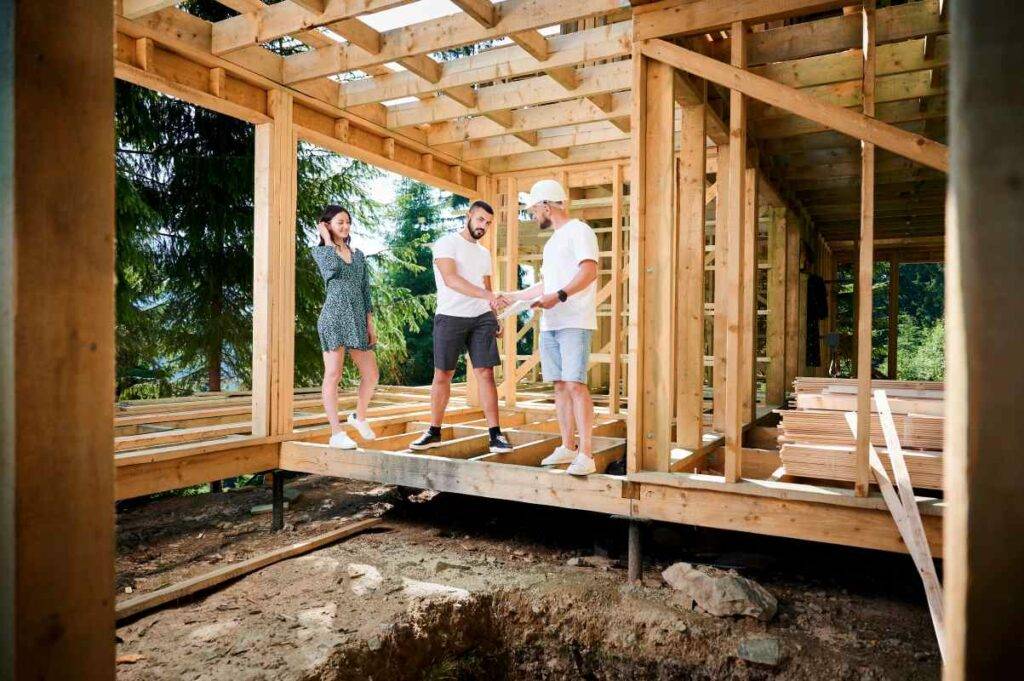Let me tell you, there’s a certain satisfaction that comes from building something with your own two hands. This weekend, that something was a wall. It wasn’t glamorous, but the feeling of accomplishment after wrestling those two-by-fours into place was pretty darn sweet.
How to Frame a Wall?
Let’s start with the first step, planning is the way to start any project.
Planning the Path
The first step was figuring out where exactly the wall would go and how big it needed to be. I spent a good hour measuring, remeasuring, and sketching out a layout that accounted for the doorway. With a battle plan in mind, it was time to gather my troops: lumber, nails, the whole shebang.
The Lumberyard Labyrinth
A trip to the lumberyard can be a daunting experience for the uninitiated. Faced with stacks of identical-looking boards, I meticulously inspected each one for warping and cracks. Trust me, you don’t want a wonky stud throwing off your entire wall! Finally, with my carefully chosen lumber loaded up, I was ready for the real work to begin.
The Sawdust Symphony
The symphony of the saw cutting through wood became the soundtrack of my weekend. I meticulously measured and cut the top and bottom plates, then came the studs. Lining them all up in a row, I marked the stud locations on the bottom plate with military precision.
Standard spacing is 16 inches on center, they say, but let me tell you, keeping everything perfectly even was a challenge! Every so often, I’d hold up a completed section to the wall and scrutinize it for any wonky gaps or uneven cuts. Thankfully, a little creative maneuvering with the tape measure usually fixed any discrepancies.
Nail-Biting Assembly
With the plates and studs prepped, it was time for the moment of truth: assembling the wall frame. It sounds simple enough, but there I was, wrestling a long, awkward frame into place. Let me just say, a helping hand would have been nice! Thankfully, with some strategic maneuvering and a whole lot of nailing, the frame finally took shape.
As I hammered away, a sense of camaraderie began to form between me and these inanimate pieces of lumber. We were in this together, transforming a pile of raw materials into a functional structure.
The Vertical Victory
The next hurdle was getting that wobbly beast upright. Maneuvering the frame into position and securing it with temporary braces felt like trying to wrangle a giant beetle. But slowly, surely, it stood there, almost magically defying gravity. Now came the critical part: making sure it was perfectly straight.
Armed with a level, I scrutinized every inch, making tiny adjustments until the little bubble sat exactly in the center. It was a victory of millimeters, a testament to human perseverance… or maybe just a touch of OCD.
Securing the Spoils
With the wall plumb and true, it was time to make it permanent. Using a combination of nails and muscle, I secured the top plate to the ceiling and the bottom plate to the floor. It wasn’t the most elegant job, but hey, it held! My arms ached, and my fingers were throbbing, but a grin stretched across my face. I had built a wall. Sure, it wasn’t the Taj Mahal, but it was mine.
The Finishing Touches
Just to add a little extra support, I decided to add some horizontal blocking between the studs, especially where I planned to hang cabinets later. Let me tell you, by that point, hammering felt more like therapy than construction. Each blow released a bit of the tension that had built up throughout the day.
As I secured the final nail and stepped back to admire my handiwork, a wave of satisfaction washed over me. The once-empty space was now filled with a sturdy wall, a testament to my perseverance and newfound carpentry skills. Sure, it wasn’t perfect.
There were minor imperfections here and there, subtle reminders of my learning curve. But those imperfections, in a strange way, added to the character of the wall. They were badges of honor, a physical manifestation of the effort and determination I poured into the project.
Framing this wall wasn’t just about creating a physical structure. It was a journey of self-discovery, a chance to learn new skills and push myself beyond my comfort zone. It instilled in me a newfound respect for the skilled tradespeople who build the homes and structures we take for granted every day.
The experience also served as a powerful reminder that with a little determination and a willingness to learn, even seemingly complex tasks can be tackled and conquered. So next time you look at a wall, take a moment to appreciate the unseen effort and skill that went into its creation. And who knows, maybe you’ll be inspired to pick up a hammer and embark on your own wall-framing odyssey.
Lessons Learned
So, there you have it, my wall-framing adventure. It wasn’t easy, but the sense of accomplishment is undeniable. Here’s what I learned:
- Measure twice, cut once: This age-old advice is gold. A single incorrect cut can throw off your entire project. I learned this the hard way when I had to scrap a slightly too-short stud and head back to the lumberyard for a replacement.
- Patience is a virtue: Rushing this process is a recipe for disaster. Take your time, ensure everything is square and level, and you’ll end up with a sturdy wall. There were moments when I was tempted to rush through a step to finish the project faster. However, I always came back to my senses and took a deep breath. Speed doesn’t matter if the wall ends up crooked or flimsy.
- Don’t be afraid to call for help: If you’re a DIY novice, don’t be a hero. An extra pair of hands can make all the difference. While I ultimately tackled this project solo, there were definitely moments where an extra person would have been a lifesaver
The Unexpected Perks:
Beyond the satisfaction of building something myself, framing this wall turned into a bit of an unexpected adventure. The repetitive hammering became a strangely meditative experience. With each blow, my mind would quiet, focusing solely on the rhythm and the satisfying connection between metal and wood. It was a welcome break from the constant mental chatter of everyday life.
There was also a sense of discovery as I familiarized myself with the tools. The power of the saw, the reassuring heft of the hammer, the surprising weight of a long two-by-four – it was all a new experience. I fumbled a bit at first, unsure of the exact angle to hold the saw or the perfect way to grip the hammer for maximum efficiency.
But with each attempt, my movements became more confident and more precise. It was a process of learning through doing, and the results were undeniably empowering.
The Minor Mishaps and How I Overcame Them
Of course, no DIY project is complete without its share of mishaps. In my case, the culprit was overconfidence. Feeling pretty good about my progress after successfully cutting the top and bottom plates, I decided to tackle the studs with a newfound sense of bravado. Big mistake. Lost in the rhythm of measuring and cutting, I made a careless mistake and ended up with a stud that was a half-inch too short. Disappointment washed over me. All that work, seemingly undone by a single slip-up.
But instead of giving in to frustration, I decided to use it as a learning experience. A quick trip back to the lumberyard for a replacement stud, and I was back on track. The incident served as a valuable reminder – that underestimating the importance of precision in carpentry can be costly, both in terms of time and materials.
The Importance of Planning
While I embarked on this project with a general idea of what I wanted to achieve, admittedly, my planning process wasn’t exactly meticulous. Sure, I had a rough sketch of the wall layout, but the finer details were left up in the air. This lack of thorough planning presented a few challenges along the way.
For instance, during the stud placement stage, I realized I hadn’t considered the placement of future electrical outlets. This meant some creative maneuvering with the stud positions to ensure there would be adequate backing for the outlets later on. While I managed to find a solution in the end, it was a situation that could have been easily avoided with a more comprehensive plan upfront.
What materials do I need to frame a wall?
To frame a wall, you need wall studs, usually 2×4 or 2×6 lumber, a top plate, a bottom plate, and headers for door or window openings. You’ll also need nails or screws, a framing hammer or nail gun, a tape measure, a level, a square, and a saw for cutting.
How do I ensure a framed wall is level and plumb?
Use a level to ensure the top and bottom plates are horizontal. When placing studs, use a plumb line or level to check they are vertical. Consistent measurement and marking ensure accurate placement of studs. Cross-bracing can help stabilize the wall and maintain its alignment during construction.
What are common mistakes to avoid when framing a wall?
Avoid misaligning the studs, not properly anchoring the bottom plate to the floor, or failing to reinforce headers. Inaccurate measurements and ignoring building codes are common errors. Always double-check measurements and ensure compliance with local building codes for safety and structural integrity.
Disclaimer: This information is for general purposes only. Consult a professional for specific advice. See our terms and conditions for details.

